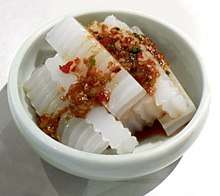Nokdu-muk
Nokdu-muk (녹두묵, 綠豆- ; "mung bean jelly",[1]) is a Korean muk, or jelly, made from mung bean starch. In its most commonly encountered form, it is also called cheongpo-muk (청포묵, 淸泡-), which literally means "clear froth jelly," owing to its clear white color. If it is colored with gardenia, the nokdu-muk is called hwangpo-muk, which literally means "yellow froth jelly."[2]
 Cheongpo-muk | |
| Type | Muk |
|---|---|
| Place of origin | Korea |
| Main ingredients | Mung bean |
| Variations | Cheongpo-muk, hwangpo-muk |
| Similar dishes | Liangfen |
| Mung bean jelly | |
| Hangul | 녹두묵 |
|---|---|
| Hanja | 綠豆- |
| Revised Romanization | nokdu-muk |
| McCune–Reischauer | noktu-muk |
| IPA | [nok̚.t͈u.muk̚] |
| Clear mung bean jelly | |
| Hangul | 청포묵 |
| Hanja | 淸泡- |
| Revised Romanization | cheongpo-muk |
| McCune–Reischauer | ch'ŏngp'o-muk |
| IPA | [tɕʰʌŋ.pʰo.muk̚] |
| Yellow mung bean jelly | |
| Hangul | 황포묵 |
| Hanja | 黃泡- |
| Revised Romanization | hwangpo-muk |
| McCune–Reischauer | hwangp'o-muk |
| IPA | [hwaŋ.pʰo.muk̚] |
Nokdu-muk is usually served cold, usually as the banchan (side dish) nokdu-muk-muchim (녹두묵무침). As it has little flavor of its own, nokdu-muk is typically seasoned with soy sauce and vinegar.
Nokdu-muk is a common food for special occasions. It is often served at Korean weddings and other celebrations. Nokdumuk is also used as a main ingredient for making the Korean royal cuisine dish called tangpyeong-chae. It is made by mixing julienned nokdu-muk, stir-fried shredded beef, and various vegetables seasoned with soy sauce, vinegar, sugar, sesame seeds, salt, and sesame oil.[3]
Hwangpo-muk (황포묵) or norang-muk (노랑묵) is a Korean food which is a yellow jelly made from mung beans. The yellow color comes from dyeing with the fruit of gardenia.[4] This jelly is particularly associated with Jeolla cuisine, and is a noted staple food of Namwon and also Jeonju (both cities in the North Jeolla province), where it is a common ingredient of Jeonju-style bibimbap.[5]
As with other varieties of muk (Korean jelly), hwangpomuk is commonly served in small chunks seasoned with vinegar, soy sauce, and other condiments; this side dish is called hwangpomuk-muchim (황포묵무침).[6]
See also
- Dotori-muk – acorn jelly
- Korean cuisine
- Laping – mung bean jelly from Tibet
- Liangfen – mung bean jelly from North China
- Memil-muk – buckwheat jelly
References
- (in Korean) Nokdumuk (녹두묵) Archived 2011-07-14 at the Wayback Machine at Nate Korean-English Dictionary
- (in Korean) Nokdumuk (녹두묵) Archived 2008-09-27 at the Wayback Machine at Doosan Encyclopedia
- (in Korean) Tangpyeongchae at Doosan Encyclopedia
- (in Korean) Nokdumuk at Doosan Encyclopedia
- Namwon: "남원시 (heading 3)". Korean Cultural Centers Federation website. Archived from the original on 2005-11-18. Retrieved 2006-05-08. Jeonju: "Special". Yonhap Repere (Korean). Retrieved 2006-05-08.
- (in Korean) Huh Young-man (허영만), Daehanminguk Shikgaek Recipes 1 (대한민국 식객요리 1) p137, Gimm-Young Publishers,Inc.(김영사), Seoul, 2008. ISBN 978-89-349-2637-5
External links
| Wikimedia Commons has media related to Cheongpomuk. |
| Wikimedia Commons has media related to Hwangpomuk. |
- Mung bean jelly
- Hwangpomuk photo (fourth from top)
- Muk: A Refreshing Taste to Whet the Appetite


